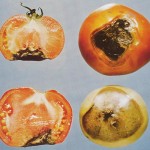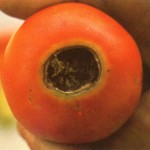Physiological Disorder
Symptoms:
Blossom end rot can affect fruit at all stages of development. The characteristic symptom is a progressive deterioration of the blossom end of the fruit, from a water-soaked appearance to a sunken, black, leathery lesion. While secondary fungal infections may occur, blossom end rot is a physiological disorder caused by calcium deficiency induced by water stress.
Control:
Careful water management practices are a key. Irrigation and/or mulching are important. Application of lime or calcium prior to planting may help. Liquid fertilization using calcium nitrate can be used for small plots.


